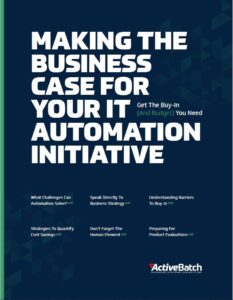How To Tie Your IT Automation To Business Goals

IT automation has always played a key role in day-to-day IT operations, from managing overnight batches to cascading updates across the enterprise. But the COVID-19 pandemic and economic pressures have renewed efforts to streamline and automate IT processes.
IT automation is a key priority for almost half of all large organizations, according to a report from Netwrix. This matches a ZDNet survey that found 81% of respondents were accelerating IT automation for 2021 in order to enable more IT innovation.
The COVID-19 crisis has caused another big shift in IT —IT’s role within the organization. Traditionally, IT leaders have had to push to get their voices heard at the enterprise level. But lock-downs and social distancing requirements have forced organizations to pull IT and business into closer alignment as digital-first projects became top priority.
Ultimately, the COVID-19 crisis accelerated a larger trend that places IT closer to the center of day-to-day business operations, customer experience and the overall business model.
At the same time, IT teams are stretched thin and struggling to keep pace with an avalanche of projects. The IT skills gap continues to make it difficult to hire and retain top talent while business teams are increasing demand for digital products and services. IT automation must play a key role in enabling IT teams to deliver projects on time.
As organizations emerge from the COVID-19 crisis, IT teams must tie their automation initiatives to key business goals in order to build on the progress that has been made in automation over the past year.
IT Automation Speeds-Up Delivery Of Digital Projects
The number of projects IT teams are responsible for is expected to grow as organizations become more reliant on digital solutions. IT is only going to get more busy. Yet 51% of business partners are already frustrated by the speed that IT teams deliver digital projects, according to a report from Salesforce.
Show how IT’s challenges are impacting business goals, and how automation will help achieve business goals.
For example, your automation initiative can:
- Free up IT resources for higher-value tasks, accelerating project timelines
- Make it possible to scale resources efficiently and cost-effectively
- Deliver data to decision-makers and customers faster, allowing the business to make better decisions ahead of others in the market.
- Enable developers to rapidly build, test and deploy new processes
- Prevent process failures and reduce MTTR so that impacts on the business are minimized
- Reliably automate processes across platforms, tying business services to disparate databases
IT automation enables employees to spend less time on tedious, manual tasks and more time on projects that require creativity and long-term planning — giving employees more time to spend on high-value projects that they care about, instead of manually triggering batch processes or searching for idle VMs.
IT Automation Is About More Than Cutting Costs
Most automation initiatives do not achieve expected cost savings. This is important to note.
Many organizations expect that an automation initiative will result in staff reductions, but more often than not, these cuts never materialize. The reason is that there are exceedingly few jobs that can be fully automated in the workplace. When onboarding gets automated, HR employees spend more time on talent acquisition. When job triggers are automated, IT employees spend more time developing services.
IT leaders should refrain from tying IT automation to headcount reductions and instead focus on the message that IT automation enables IT to accomplish more with existing resources.
It’s estimated that large enterprise IT teams spend almost half of their time keeping the lights on, mostly in the form of manual processes, at a cost of $4.8 million per year. Approximately 38% of manual IT tasks could be automated for an average annual savings of $2 million, according to research from DynaTrace.
With the right automation tools, IT teams can now drastically increase the time spent on innovative projects and development, accomplishing far more without having to increase resources.
When building your business case, consider what your team’s workload will be moving forward. How many more projects do you expect to be responsible for, and will this require an additional team member? Can automation be used to reduce workloads so that your current team has time for more projects?
There are other areas for cost savings as well, for example, managing cloud-based resources. As cloud environments scale, server sprawl can quickly cause cloud costs to spiral out of control as servers are left idle. Automation tools can help rein in these unexpected costs by provisioning and deprovisioning cloud resources based on real-time demand.
Don’t Forget The Human Element
Numbers can be used to great effect and your business case isn’t going to hold water without them. But numbers are abstract and it can be difficult to build a strong case that relies only on spreadsheets.
IT automation has the potential to impact day-to-day jobs across the organization, or at least across your team. Make sure your business case includes real-world stories that drive home the need for automation. Include anecdotes where a manual process caused significant delays, or an unexpected issue tied-up senior team members. Focus on specific cases where automation could have saved the enterprise time (and money) while facilitating key business projects.








